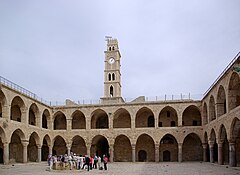Khan al-Umdan
| Khan al-Umdan | |
|---|---|
| خان العمدان | |
 |
|
| Alternative names |
Hebrew: ח'אן אל עומדאן Baha'i name: Khán-i-'Avámid |
| General information | |
| Type | Caravanserai |
| Architectural style | Ottoman |
| Location | Acre, Israel |
| Completed | 1784 |
| Technical details | |
| Floor count | 2 |
| References | |
| archnet.org | |
Khan al-Umdan (Arabic: خان العمدان: "Caravanserai of the Pillars" or "Inn of the Columns", also known as Khán-i-'Avámid) is the largest and best preserved khan in Israel. Located in the Old City of Acre, it is one of the prominent projects constructed during the rule of Ahmed Jezzar Pasha in Galilee, under the Ottoman era.
Being one of four Khans in Acre, Khan al-Umdan was built in 1784 on the place of the Royal Customs house of the Kingdom of Jerusalem. Due to its plethora of columns the khan was named Khan al-Umdan which means "Inn of the Columns" or "Caravanserai of Pillars". It incorporates forty columns made of granite that were taken from Caesarea, Atlit and the ruins of Crusader monuments in Acre itself.
Due to its proximity to the port, Khan al-Umdan has throughout its history been an important trading spot. Merchants arriving at Acre used the khan as a warehouse while the second floor functioned as a hostel.Camel caravans once brought produce and grain from Galilean villages to the city's markets and port.
The khan later gained importance to the Bahá'í Faith (as the Khán-i-'Avámid) as it was the site where Baha'ullah used to receive guests, and later the site for a Bahá'í school.
In 1906 a clock tower was added adjacent to the main entrance to the khan to commemorate the silver jubilee of the rule of Ottoman sultan Abd al-Hamid II. It is similar to the Jaffa Clock Tower, a building dedicated to the same purpose, along with five more towers in Ottomam Palestine (in Jerusalem, Haifa, Safed, Nablus, and possibly Nazareth) and over a hundred across the entire empire.
...
Wikipedia
